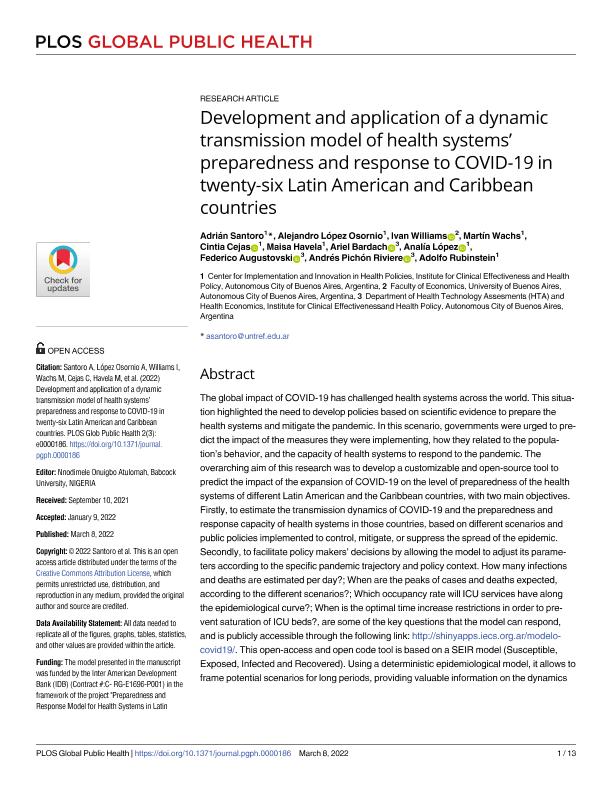Mostrar el registro sencillo del ítem
dc.contributor.author
Santoro, Adrián Gabriel

dc.contributor.author
López Osornio, Alejandro
dc.contributor.author
Williams, Iván

dc.contributor.author
Wachs, Martín
dc.contributor.author
Cejas, Cintia
dc.contributor.author
Havela, Maisa
dc.contributor.author
Bardach, Ariel Esteban

dc.contributor.author
López, Analía
dc.contributor.author
Augustovski, Federico Ariel

dc.contributor.author
Pichón Riviere, Andrés
dc.contributor.author
Rubinstein, Adolfo Luis

dc.date.available
2023-10-18T14:40:16Z
dc.date.issued
2022-03
dc.identifier.citation
Santoro, Adrián Gabriel; López Osornio, Alejandro; Williams, Iván; Wachs, Martín; Cejas, Cintia; et al.; Development and application of a dynamic transmission model of health systems’ preparedness and response to COVID-19 in twenty-six Latin American and Caribbean countries; Public Library of Science; PLOS Global Public Health; 2; 3; 3-2022; 1-13
dc.identifier.uri
http://hdl.handle.net/11336/215334
dc.description.abstract
The global impact of COVID-19 has challenged health systems across the world. This situation highlighted the need to develop policies based on scientific evidence to prepare the health systems and mitigate the pandemic. In this scenario, governments were urged to predict the impact of the measures they were implementing, how they related to the population’s behavior, and the capacity of health systems to respond to the pandemic. The overarching aim of this research was to develop a customizable and open-source tool to predict the impact of the expansion of COVID-19 on the level of preparedness of the health systems of different Latin American and the Caribbean countries, with two main objectives. Firstly, to estimate the transmission dynamics of COVID-19 and the preparedness and response capacity of health systems in those countries, based on different scenarios and public policies implemented to control, mitigate, or suppress the spread of the epidemic. Secondly, to facilitate policy makers’ decisions by allowing the model to adjust its parameters according to the specific pandemic trajectory and policy context. How many infections and deaths are estimated per day?; When are the peaks of cases and deaths expected, according to the different scenarios?; Which occupancy rate will ICU services have along the epidemiological curve?; When is the optimal time increase restrictions in order to prevent saturation of ICU beds?, are some of the key questions that the model can respond, and is publicly accessible through the following link: http://shinyapps.iecs.org.ar/modelo-covid19/. This open-access and open code tool is based on a SEIR model (Susceptible, Exposed, Infected and Recovered). Using a deterministic epidemiological model, it allows to frame potential scenarios for long periods, providing valuable information on the dynamics of transmission and how it could impact on health systems through multiple customized configurations adapted to specific characteristics of each country.
dc.format
application/pdf
dc.language.iso
eng
dc.publisher
Public Library of Science

dc.rights
info:eu-repo/semantics/openAccess
dc.rights.uri
https://creativecommons.org/licenses/by/2.5/ar/
dc.subject
COVID-19
dc.subject
PANDEMICS
dc.subject
PUBLIC POLICY
dc.subject
HEALTH CARE POLICY
dc.subject
EPIDEMIOLOGY
dc.subject
INTENSIVE CARE UNITS
dc.subject
CARIBBEAN
dc.subject
PUBLIC AND OCCUPATIONAL HEALTH
dc.subject.classification
Otras Ciencias de la Salud

dc.subject.classification
Ciencias de la Salud

dc.subject.classification
CIENCIAS MÉDICAS Y DE LA SALUD

dc.title
Development and application of a dynamic transmission model of health systems’ preparedness and response to COVID-19 in twenty-six Latin American and Caribbean countries
dc.type
info:eu-repo/semantics/article
dc.type
info:ar-repo/semantics/artículo
dc.type
info:eu-repo/semantics/publishedVersion
dc.date.updated
2023-07-10T11:50:17Z
dc.identifier.eissn
2767-3375
dc.journal.volume
2
dc.journal.number
3
dc.journal.pagination
1-13
dc.journal.pais
Estados Unidos

dc.description.fil
Fil: Santoro, Adrián Gabriel. Consejo Nacional de Investigaciones Científicas y Técnicas. Oficina de Coordinación Administrativa Parque Centenario. Centro de Investigaciones en Epidemiología y Salud Pública. Instituto de Efectividad Clínica y Sanitaria. Centro de Investigaciones en Epidemiología y Salud Pública; Argentina
dc.description.fil
Fil: López Osornio, Alejandro. Instituto de Efectividad Clínica y Sanitaria; Argentina
dc.description.fil
Fil: Williams, Iván. Universidad de Buenos Aires. Facultad de Ciencias Económicas; Argentina
dc.description.fil
Fil: Wachs, Martín. Instituto de Efectividad Clínica y Sanitaria; Argentina
dc.description.fil
Fil: Cejas, Cintia. Instituto de Efectividad Clínica y Sanitaria; Argentina
dc.description.fil
Fil: Havela, Maisa. Instituto de Efectividad Clínica y Sanitaria; Argentina
dc.description.fil
Fil: Bardach, Ariel Esteban. Consejo Nacional de Investigaciones Científicas y Técnicas. Oficina de Coordinación Administrativa Parque Centenario. Centro de Investigaciones en Epidemiología y Salud Pública. Instituto de Efectividad Clínica y Sanitaria. Centro de Investigaciones en Epidemiología y Salud Pública; Argentina
dc.description.fil
Fil: López, Analía. Instituto de Efectividad Clínica y Sanitaria; Argentina
dc.description.fil
Fil: Augustovski, Federico Ariel. Consejo Nacional de Investigaciones Científicas y Técnicas. Oficina de Coordinación Administrativa Parque Centenario. Centro de Investigaciones en Epidemiología y Salud Pública. Instituto de Efectividad Clínica y Sanitaria. Centro de Investigaciones en Epidemiología y Salud Pública; Argentina
dc.description.fil
Fil: Pichón Riviere, Andrés. Instituto de Efectividad Clínica y Sanitaria; Argentina
dc.description.fil
Fil: Rubinstein, Adolfo Luis. Consejo Nacional de Investigaciones Científicas y Técnicas. Oficina de Coordinación Administrativa Parque Centenario. Centro de Investigaciones en Epidemiología y Salud Pública. Instituto de Efectividad Clínica y Sanitaria. Centro de Investigaciones en Epidemiología y Salud Pública; Argentina
dc.journal.title
PLOS Global Public Health
dc.relation.alternativeid
info:eu-repo/semantics/altIdentifier/url/https://dx.plos.org/10.1371/journal.pgph.0000186
dc.relation.alternativeid
info:eu-repo/semantics/altIdentifier/doi/http://dx.doi.org/10.1371/journal.pgph.0000186
Archivos asociados
